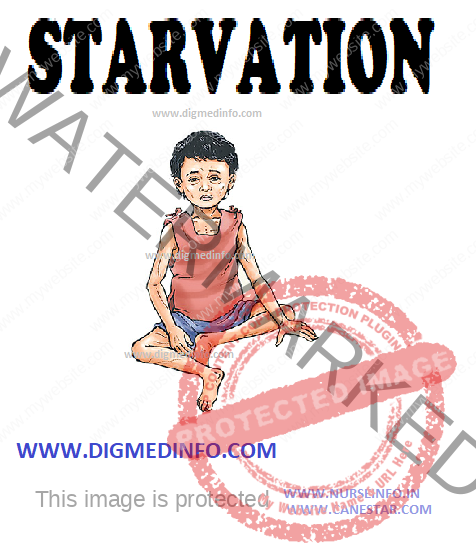STARVATION – General Characteristics, Clinical Features and Treatment
GENERAL CHARACTERISTICS
Severe starvation on a mass scale occurs during special situations like prolonged war, drought, and other natural or political calamities. Chronic starvation of different grades affects large number of people in the developing countries, even during normal times. Several famines have occurred during the 19th and early part of the 20th centuries. Famines were a regular occurrence in Bengal during the colonial rule. Though acute and chronic food shortage occur from time to time in various parts of India as a result of floods, drought or earthquakes, widespread famine has not occurred in the latter part of this century.
In addition to food shortage, inability to ingest or digest and absorb food also results in starvation. Individuals may resort to starvation voluntarily or this may result from psychiatric abnormalities.
Loss of weight amounting even up to 50% of body weight is the most prominent feature. The weight loss is initially caused by the loss of fluid. Later on it is owing to catabolism of tissues to meet energy needs. The body stores of carbohydrate (liver and muscle glycogen) are depleted within two to three days and fat is mobilized in the form of free fatty acids which is used as fuel by the muscles. Glucose is spared for the brain. Tissue proteins are also broken down in order to meet the energy needs. Protein synthesis is diminished and alanine is released by the muscles to the liver for conversion to glucose, which is made available to the brain. During prolonged starvation, brain metabolism can adapt to use betahydroxybutyrate and acetoacetate also as fuel. Generalized emaciation results. Liver and intestines are the first to lose
tissue, and this is followed by muscles and skin. The brain is preserved right till the end.
CLINICAL FEATURES
The patient is apathetic and irritable. The loss of fat around the buttocks, thighs, back, and buccal region gives the characteristic appearance with prominence of bones and dry, thin, inelastic, loose skin. A brownish, patchy pigmentation is generally encountered. The hair becomes characteristically dry and easily pluckable. During cold weather cyanosis of extremities may develop. Systemic disturbances Cardiovascular changes include bradycardia, lowered systolic and diastolic pressure, and reduction in venous pressure and cardiac output. The heart size is also reduced. Respiratory rate is lowered, so also the vital capacity. Growth hormone level is decreased.
Basal metabolism is lowered. Corticosteroid is normal. In both sexes sexual function is diminished leading to loss of libido in males and amenorrhea in females. Hypothermia may develop on exposure to cold. Though personality changes may be manifest, the intellect usually remains clear till the end. Capacity for work is reduced due to loss of muscle mass. Mild normocytic normochromic anemia is not uncommon.
In some individuals dependent edema appears even without lowering of plasma albumin. Nocturnal polyuria is common though the renal function is not grossly affected.
TREATMENT
The course of treatment should depend upon the severity of the disorder. Mild cases of starvation require only oral feeds. Overzealous dietary supplementation may lead to diarrhea and death. In the early stages, gradual introduction of easily absorbable and predigested food may be necessary till the alimentary functions return to normal. Fats and fatty foods have to be avoided to prevent diarrhea. Skimmed milk is superior to whole milk.
Skimmed milk powder reconstituted to give 10-15% strength is well tolerated if given as small feeds (up to 100 mL) frequently. A daily intake of about 3,000 kcal and 100 g proteins should be aimed at. Severely debilitated patients should be fed using an intragastric tube in order to ensure adequate intake. After the initial rapid gain in weight due to correction of dehydration, a steady increase of 1-1.5 kg/week can be considered as adequate response. In all cases of severe starvation especially if complicated by intercurrent illnesses and diarrhea, parenteral nutrition should be resorted to without delay.
If starvation occurs on a wide scale, relief camps have to be organized to provide shelter, food, potable water and general sanitation. Community kitchens may have to be set up to provide food. In these endeavours, the medical personnel have to work in close liaison with social service organizations and governmental agencies.


